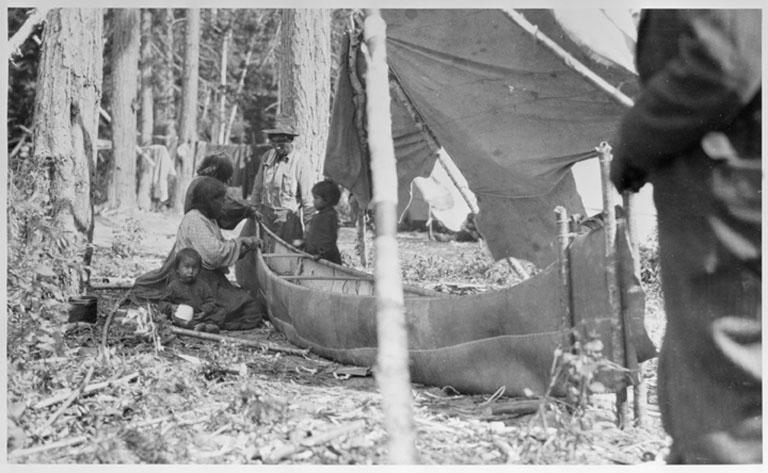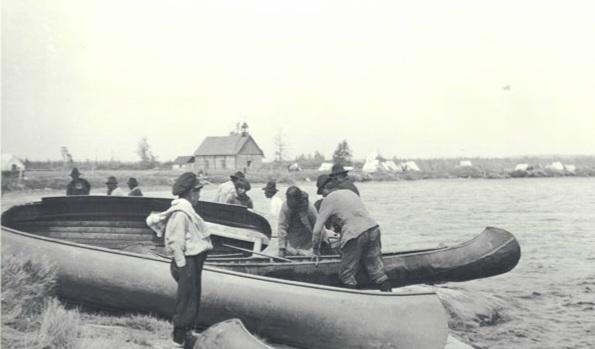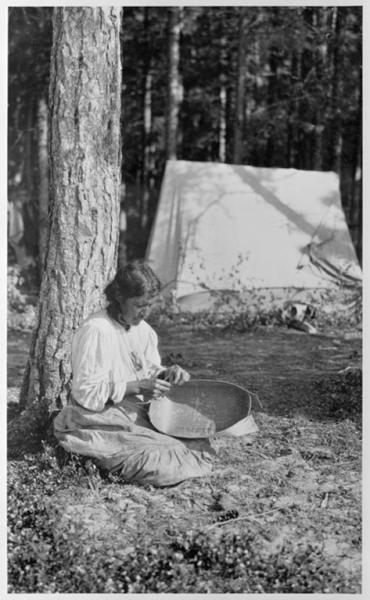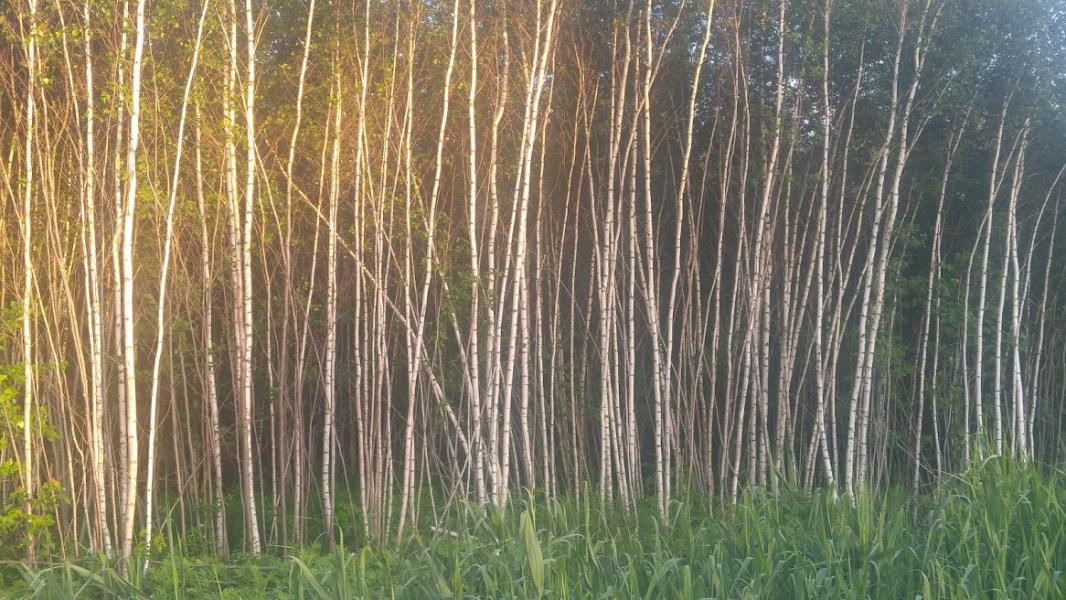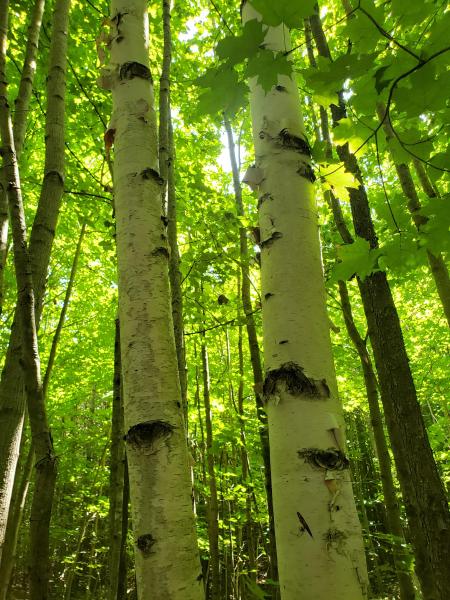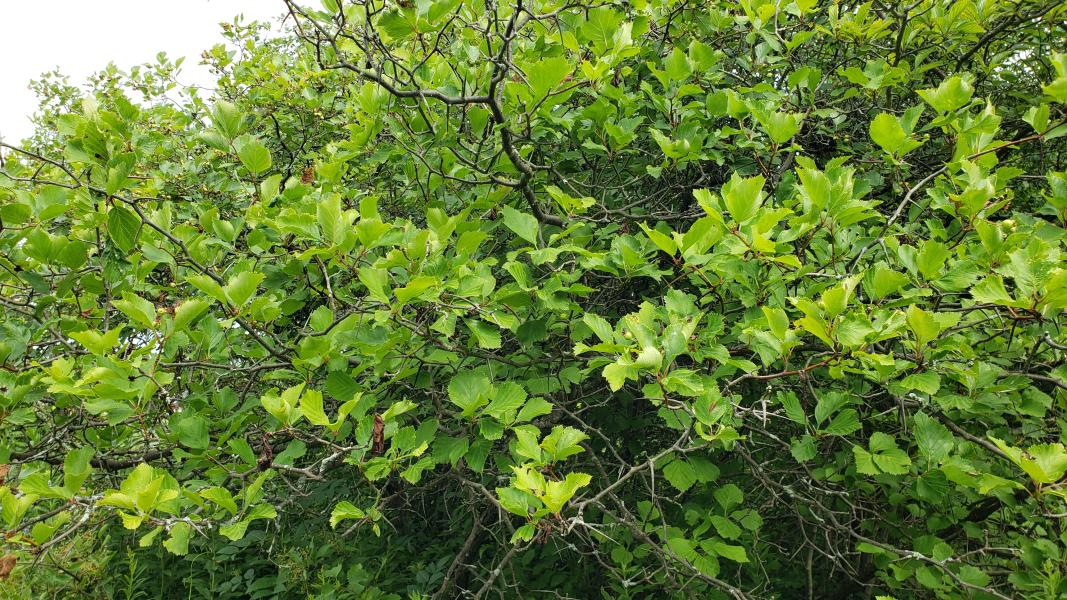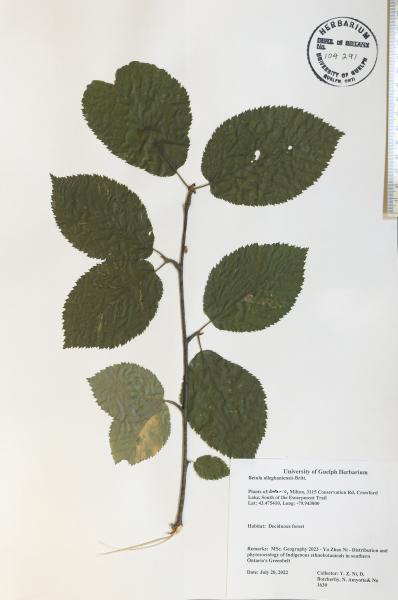
Names and Their Meanings
Paper birch - Betula papyrifera
Yellow Birch - Betula alleghaniensis
Black Birch - Betula lenta
Speckled Alder - Alnus incana
Paper birch
Description
A medium sized tree growing 20-30 m tall. The bark is thin, smooth and white, peeling in thin strips, and the twigs are hairy. The deciduous leaves are alternate, oval to triangular shaped, and are pinnately veined, with margins double teethed. White birch prefers moist, well drained, acidic, sandy to silty loam soils, occurring in open areas in mixed wood forests. These trees are shade intolerant and need full sunlight. They form part of early succession communities in forests and are rapidly growing and relatively short lived, up to 150-200 years.
Conservation Status
SNA (No Status Rank) in Ontario; S5 (Secure) rank in Québec and New York State
Yellow Birch
Description
Yellow birch is a stately deciduous tree that reaches between 20 and 30 m in height. The leaves are alternate, simple, ovate to oblong in shape with a pointed dip, double teethed margins, and grow to 4 – 6 inches long. They are slightly hairy on the underside when young, and often give off a wintergreen odor when the midrib is crushed. Yellow birch’s range is from Newfoundland and Nova Scotia in the North, to Southeast Manitoba in the West, to Illinois, Ohio and Pennsylvania in the south, up throughout New England and the Eastern seaboard. Fifty percent of all Yellow birches in North America grow in Québec, which is why it is the Provincial Tree. Lots of wildlife enjoy eating the stems of both Yellow birch and Black/Sweet birch.
Conservation status
S5 (Secure) in Ontario and New York; S4 (Apparently Secure) in Québec
Black Birch
Description and Habitat
Black birch is native to Eastern North America, yet very rare in Canada; it is only found in southernmost Ontario, an area that includes our study area. We have included it here because it has many of the same medicinal properties and ethnobotanical uses as Yellow birch. Black birch is distinguished by its dark, shiny bark with contrasting lenticels, that does not peel to the same extent as white and yellow birch bark do. This tree is also monoecious and deciduous, growing between 60 and 70 feet tall. Black birch has wintergreen-smelling twigs that are golden brown, with a papery outer bark, and a layer of green, wintergreen-containing inner bark. It’s leaves are simple, with teethed margins; they turn to lovely golden yellow foliage in the autumn. Black birch does not prefer swampy areas, but rather woodlands, preferring north-facing slopes, moist yet well-drained, rocky, sandy loams.
Conservation Status
S1 (Critically Imperilled) in Ontario, but S5 (Secure) across the border in New York State
Speckled Alder
Description
Speckled alder is a fast-growing, thicket forming deciduous small tree or shrub that often in a multi-trunked form, 20 - feet tall. It is a circumpolar alder whose range extends southwards in the Northeast around the Great Lakes across to the Eastern seaboard as far south as Indiana, Ohio, and Virginia. It is commonly called speckled alder due to the white lenticels that speckle its bark. Leaves are leathery and dull green, with wrinkled surfaces (the source of the name “rugosa,”) and serrated margins. Alder prefers to grow moderately acidic, moist soils in moist swamps, wetlands, riparian habitats, stream banks and pond margins, forming dense thickets that feed and house wildlife, including deer, beavers, goldfinches, the green comma butterfly, and the harvester butterfly.
Conservation Status
S5 (Secure) in Ontario, yet there is no data for New York State, Québec, or New England.
Uses
Birches are so profoundly an Algonquian cultural keystone species that their importance cannot be overstated. Paper birch is thus named for its importance since time immemorial among Anishinaabe and Algonquian peoples as a canoe birch, its bark a source of craft and utility for canoe technology. It is also used for vessel-making for water and basket making for ricing and other bowls; as waterproof covers for traditional homes such as waaginongaan and wigwams; for the scrolls of awikhigan (material for writing in iconography); for the art of birch biting; for creating birch cones used as moose calls; and for contemporary crafting such as making earrings. White and yellow birch are prized for making torches and fires; Lac du Flambeau is named for the birches that surround it, whose materials can be made into torches. Removing bark is a seasonal activity; bark is to be removed in late spring, when the sap is rising. There are beautiful photographs of bitten birch transparencies in the back of Frances Densmore’s “Indian Uses of Wild Plants for Crafts, Food, Medicine, and Charms.”
The “oil of wintergreen” (methyl salicylate) in birches is a preservative and as an oil or made into a salve is a medicinal rub to ease sore muscles, rheumatism, and joint pain. Wintergreen oil has been used as a flavoring in various sweets; Sweet birch is the species that has been tapped to make birch beer, made from its fermented sap. The buds can be used as a nutritional food/medicine for stomach disorders and to relieve cramps and diarrhea, and digestive tract issues.
Yellow birch is well-known by hunters and trappers as providing abundant and quick kindling material in the form of bark that it has shed onto the ground, or that can be peeled off the tree, when dry. The dry curls of yellow birch bark are also very light in weight, so easy and compact for hunters and other travelers to carry with them to use as kindling, once they make camp. Amber Adams wrote that birches are present in the Haudenosaunee Creation Story; Waugh wrote that all three birches were tapped for sap and twigs, leaves and buds used to make a flavorful tea or drink, although White Birch does not have that same flavor as Wintergreen. Yellow Birch is a source of wood that has been used to make corn pounders. All three birches are noted for their beautiful wood colors and grain.
Frances Densmore wrote in 1926 that Speckled Alder tea has been used on its own or in combination with Arrow wood/maple leaved viburnum for their alternative, emetic, and astringent properties. Waugh recorded the use of Alder among Ojibway people in Wikwemikong, Long Lake, Nipigon, and Lac Seul in 1916 and 1917. Alder was combined with balsam, scouring rush, ostrich fern, moosewood/striped maple and ground hemlock/canada yew as a medicine for gonorrhea; also for breaking out on face or body, for sore throat, use bark equal parts with red osier dogwood. He recorded that they also used Alder for a yellowish dye. Among Haudenosaunee, Waugh recorded in 1916 a combination of Hemlock roots and bark and Alder bark to color spoons and other wooden articles a deep red color. Alder is rot resistant. Fernald and Kinsey noted Alder buds and young inner bark could be used as a nibble in the bush or as emergency food.

